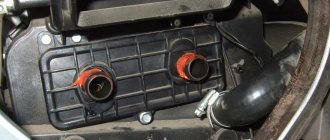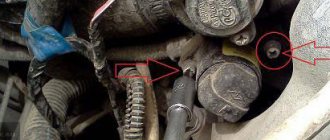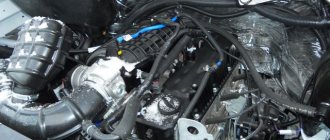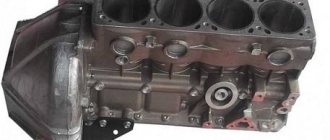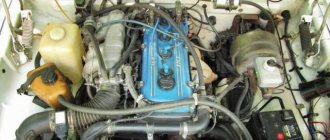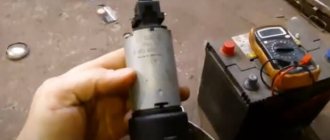During the operation of a car, a common situation is that after turning the ignition key, the car starts, the engine starts to work and stalls after a few seconds. As a rule, 3-5 seconds pass from the moment of starting to stopping the internal combustion engine. Before the engine stops completely, engine vibrations are also noticeable, the power unit shakes and operates very unstable.
This happens as a result of a decrease in speed, the resonance effect of a rotating crankshaft, etc. When you try to start the engine again, the engine may no longer start, or the situation described above may repeat again.
The reasons for this problem vary. The main thing is that if the car starts and stalls, this indicates that in-depth diagnostics are needed. Next we will talk about what to do in such a situation, as well as how to find the reason why the engine stalls after starting.
Read in this article
Recommendations
Comments 60
And how did the epic end? I have similar syndromes =(
remove the chip from the mass air flow sensor and start it! If it doesn’t help, then put it back on and take it off. Even if the pump dies, then at xx it will create the necessary pressure, but in power mode it will not work! pull the chips and look!
So, I’ll check with the MAF tomorrow morning, but if I reset the MAF, it generally stalls immediately after starting, but sometimes it lasts for 5-20 seconds, but then it dies immediately. What else to watch? I installed the new phases, for some reason they are shorter than the old one, by 0.2 cm somewhere, +- 0.1. Rxx seems to be working, I checked it as a direct plus, according to the book it was written to check the central socket and the side ones (in turn), it closes, I check the two outer ones, it also closes, although nothing is written about the outer sockets... The mass air flow sensor is also intact, it seems like it gives out 2.80 ohms and not the norm of 2.6 as it should be...what is the reason?
according to IAC - everything depends on the ECU firmware! DPRV - question to the manufacturer DMRV - it is still a sensor and it also has brains!
filter, there’s nothing else, and maybe a fuel filter, but then it won’t work
I changed the filter, the old one was spinning the same way, they blamed it, but it didn’t turn out that way...
Guys, I’m sorry that it’s not much on topic, but I hope that there’s nothing wrong with it, on the contrary, at idle it works for me, when I press the gas pedal, it feels like there’s either not enough fuel, or it’s terribly overflowing, periodically this overflow or The lack of fuel disappears and the car drives quite normally. What could be, where to go? Thanks for understanding. Machine 3102 with ZMZ 406.
I had this happen because of the injectors.
Do you think it's worth cleaning? Or should I change it anyway?
Cleaning didn't help me, I changed it
Thank you. I'll try to clean it tomorrow
I agree with what was said above on my own - after replacing the filters, if that doesn’t help, try to measure the pressure of the fuel line. 1 the pressure of the pump without a fine filter (in front of the ramp) should be at least 4.5 kgcm 2 at idle, the pressure in the rail should be at least 2.5 kgcm3 most likely The check valve on the fuel rail failed, I replaced about a dozen at one time until I found an old model - a dismountable one - all the problems with idle were gone, good luck
really? because if I give it gas, everything is perfect, it doesn’t hold idle even for 5 seconds, it stalls...
It was due to a clogged filter in the tank (pyramid)
Signs of trouble
There are three main symptoms of problems with the injector (injector malfunction) of a Gazelle car.
A characteristic sign of a malfunction can be considered detonation, which is unpleasant for the driver’s hearing.
It destroys the motor, which is why it is so important to find the fault in time and fix it. If the engine stalls for no reason on the road, and subsequent attempts to start it lead to the goal only after many repetitions, this is a clear sign of a faulty injector. The power of the power unit does not inspire approval as before. In common parlance, the car does not “pull”. When climbing a hill, the movement turns into a real test of the driver’s nervous system and can be detrimental to the engine.
When climbing a hill, the movement turns into a real test of the driver’s nervous system and can be detrimental to the engine.
Won't start on
Diagnostic sequence
There are no exact recommendations for the diagnostic sequence. If the engine stalls periodically, it is better to wait a little time and try to find out what the problem is. It is not difficult to determine a malfunction in the operation of an internal combustion engine - electronic diagnostic systems allow the electronic control unit to record problems. Verification methods based on visual and auditory observations should be kept in mind. The presence of extraneous noise, changes in the color of gas exhaust and other signs indicate a malfunction of the engine. Car owners with extensive driving experience know that minor faults lead to big problems - major engine repairs or complete replacement. Periodic inspections of parts and components of the unit, which are recommended to be carried out once a week, help to avoid such problems:
- check the level of engine oil and antifreeze;
- inspect for damage and ruptures of tips, connectors, hoses;
- monitor the operation of gaskets and seals.
Gas 3110 won't start, injector 406 stalls
The car stalled while driving at high speed and will not start. The starter turns, but there is no response. After much torment, the car finally started, but when moving, the car jerks, hesitates, does not pull, and after some time stalls. This very often occurs in hot weather on the highway. There may be several reasons: - the fuel pump has overheated, - the RTD fuel pressure regulator does not work (also overheating), which leads to increased pressure in the fuel system, - a break in the crankshaft sensor,
There are several things you can try to resolve these issues. 1. Using the ignition key, turn on the fuel pump until it is completely processed three times. 2. Press the accelerator pedal to the floor and turn the ignition switch to start. 3. Under the hood, remove one of the gasoline hoses (pre-prepare an empty container for draining the fuel). Do not allow gasoline to get into the exhaust manifold; a fire may occur. We remove the hose from the tube gradually, thus releasing excess pressure. The fuel pressure regulator should be kept at idle. 2.7 atm., and when re-gasping up to 3 atm. If the RTD holds 4 atm. and higher, the ECU may turn off the injectors due to the mixture being too rich and the pressure being too high.
You can check the RTD with a conventional tire inflator. Venting air at 3 atmospheres indicates normal operation of the RDG. (show video of pressure measurement) 4. Cool the fuel pump with water or a cold cloth. 5. If you cannot hear the pump operating, then perhaps there is no power supply to it or fuse number 9 in the right fuse block has blown.
Perhaps the relay does not work and does not supply voltage to the EBN. In this case, remove the relay; it is located in the right rear part of the engine compartment, engine control relay unit. The relay may be brown or orange. Close contacts “30” and “87”. If the pump starts working, replace the EBN relay. Otherwise, check the green-violet wire on the EBN. If the wire is intact, replace the pump.
You can check the functionality of the EBN switching relay itself: a) Check fuses No. 9 and No. 10, in the right fuse block. b) Remove the relay c) measure the voltage at contact “+30” and “-85” U=12v d) If there is no voltage, then measure at “+30” and the vehicle’s ground. If U=12v is present, you need to check whether the wire (brown-green and red) is broken. 6. Check the crankshaft position sensor for a break. This is the only sensor that, if it is faulty, will not start the car.
Gazelle 406 engine injector does not start reasons
One day the Gazelle stopped starting? The reason lies in engine malfunctions. The problem may be related to both the mechanical part and the electrical part. To fix the problem, you will have to diagnose a number of parts.
Causes
Not for various reasons. Some of them are related to the time of year, while others are related to wear and tear. This problem can also be caused by the negligence of drivers who are careless about the maintenance of the power unit.
So, if not, there may be several reasons:
- malfunction of fuel system components;
- problem in valves and cylinders;
- malfunctions in the ignition system;
- breakdowns in the starter and battery;
- air supply;
- sensors and control unit.
Diagnostic and repair methods
Once the main reasons why it doesn’t work have been identified, we can move on to consider the issue of accurate diagnosis and troubleshooting. Each of the components will require its own set of tools, but it is best to have a set of keys and screwdrivers, a tester, WD-40 and electrical tape on hand. Let's begin a step-by-step analysis of the problem.
Fuel cells
It is worth understanding that almost all elements affect the starting of the motor. For example, since the Gazelle was produced both with carburetor and injection, the injection elements will be different. This means that the reasons for possible breakdowns will not be the same.
The Gazelle-406 engine is an injection version of the vehicle. It has injectors installed, which can be the source of the problem. If cleaning has not been carried out, then most likely the injectors are dirty. To fix this, you need to remove the parts from the machine and send them for cleaning. If, during the process of restoring the functionality of the injectors, it turns out that the product cannot be repaired, then it must be replaced.
A fuel pump malfunction may be due to a breakdown inside the module. To check whether the pump is pumping, you need to get behind the wheel of the car and turn the ignition key to the second position. In this case, a characteristic noise should begin from behind, which will mean that the pump is in working condition.
Particular attention should be paid to the condition of the fuel filter. According to the service manuals and recommendations of the manufacturer, the fuel filter element must be changed every 40,000 km.
If this is not done, the filter becomes clogged and does not allow fuel to pass through properly, which results in a lean mixture in the cylinders, or gasoline does not get in for ignition at all.
Valves and cylinders
Quite a few motorists monitor the condition of the power unit. As you know, wear and tear does not spare anyone or anything, and accordingly, burnout of valves and pistons can lead to the fact that at first the engine begins to start poorly, and then stops altogether.
The second nuance is the high degree of wear of the valves, which is why they do not fit tightly to the seats. Gasoline drips through the cracks into the cylinders. It turns out that there is an overflow of fuel, and since the spark plugs are filled, the power plant does not start due to the lack of a spark.
Ignition system
Spark plugs and high-voltage wires directly affect engine starting. Accordingly, breakdowns in the elements will cause a failure of the entire system. To check spark plugs, a special stand is used, although you can check it the old fashioned way:
- We unscrew the candle from the well.
- We connect the armored wire.
- Connect the spark plug body to ground.
- We try to start the engine.
If everything is in order with the spark plugs, then there will be a spark between the contacts. If the part is faulty, then there will be no spark, and accordingly, the element must be replaced. Checking armored wires is quite simple. All elements are removed from the car and measured by a tester. The resistance on each high voltage wire should be 5 ohms.
Starter and battery
Lack of nutrition is another reason why... As practice shows, in many cases the battery is to blame. This is a fairly common occurrence in winter, when the car sits in the cold for a long time. Charging the element will help solve the problem.
It is quite difficult to diagnose a starter malfunction without removing the unit. Therefore, if there is a suspicion that it is this particular element that is failing, we remove it and take it to an electrician.
Air supply
A frequent reason that the Gazelle-406 engine does not start is a clogged air filter. It is recommended to change this element every 20,000 km. Removing the part from the car takes 5 minutes. It is also worth taking the time to diagnose the throttle valve, which may be clogged. Cleaning should help solve the problem.
The engine chokes when you press the gas pedal
A fairly common situation during the operation of a vehicle is when failures occur when pressing the gas pedal, the engine stalls when over-accelerating, the power unit does not pick up speed, choke, etc.
Let's start with the fact that there can be many possible reasons for this type of malfunction. In the process of initial diagnosis, an important condition is the observation of characteristic symptoms, which allows you to more accurately and quickly determine the malfunction. Next, we will look at why the engine stalls when you press the gas pedal, as well as in what cases the engine stalls when you press the gas.
The engine stalls when you press the gas: possible reasons
As already mentioned, certain signs allow you to localize the existing problem. For example, if the engine stalls when “cold” after pressing the gas pedal only when the humidity outside is high, moisture may well be the cause.
- The problem is that water particles can accumulate on the distributor cap. Such accumulations of moisture settle on the inner surface of the lid in the form of condensation. Let us add that on some cars the cover is shaped in such a way that allows current to pass through the distributor, that is, the discharge is simply not supplied to the spark plugs. At the same time, at idle, the internal combustion engine operates normally, but when you press the gas, the problem manifests itself. This is explained by the fact that the distributor, at the moment of gas supply, begins to operate in an accelerated mode, passing a larger amount of electricity. Taking into account the fact that moisture has accumulated in the distributor housing, a malfunction immediately occurs and the engine choke, as a weak spark is formed at the spark plugs. To check, it is enough to observe whether such a failure is present on a warm engine, and also whether the malfunction appears when it is dry outside. You can also put the car in a heated garage or parking lot for several hours, and then evaluate the stability of the internal combustion engine after starting and at the moment you press the gas.
- Another reason why the unit may choke is that there is no vacuum in the fuel system. In other words, air leakage occurs, which affects the fuel pressure and the composition of the fuel-air mixture. Usually the problem progresses gradually and can occur on both a cold and hot engine. The fact is that in order to accurately determine the amount of fuel supplied at a specific point in time, the vacuum in the fuel system plays an important role.
Engine stalls when switching to gas
The presence of gas equipment in a car, along with certain advantages, can cause a number of inconveniences to the driver. One of the common problems is that the engine stalls when switching from gasoline to gas. The problem can manifest itself in different ways. In the first case, the unit stalls immediately, that is, at the moment of transition; in the second, the engine choke after the driver presses the accelerator after the transition, that is, when the engine is already running on gas in idle mode.
The reason is that a cold reducer does not evaporate the supplied gas in the required volume. Please note that we should not exclude the fact that the degree of heating of the gearbox depends on the characteristics of its connection (to the manifold, to the heater hoses, etc.), as well as on the level of coolant in the system. Let us add that another common cause may be the gas injectors themselves. In some cases they need to be cleaned, in others it is better to replace them with more efficient ones.
What's the result?
If the engine choke when you press the gas, you should start by checking the spark plugs. Very often, a problem with an engine is solved by simply installing new spark plugs. Please note that when the check light comes on on the dashboard, this is the basis for computer diagnostics of the engine. The specified diagnostics in many cases allows you to narrow down the scope of troubleshooting as much as possible and quickly eliminate the breakdown.
The engine stalls at idle: solving the problem
When making repairs yourself, you may need to carry out the following actions:
- complete replacement of sensors;
- restoration of the performance of individual elements, whose life can be extended;
- preventive work to avoid recurrence of problems of this kind.
Complete replacement of broken equipment is required when some devices break down. When the engine stalls, it cannot be avoided if the reason lies in faulty throttle or idle position sensors. Often they prefer to replace the throttle valve itself. The carburetor or injector is replaced only if cleaning does not help.
The engine turns off periodically when idling
It doesn’t play any role, the car engine turns off sometimes or with a certain regularity - the reasons for the occurrence and solution of the problem do not change. The main thing to remember is that even a small frequency of the problem is a sign of poor performance of the car’s internals.
The car stalls at idle even though it starts
If the car, after starting the engine, jerks when you press the gas, the speed is unstable, and then drops completely and it stalls, then the fault probably lies with the fuel pump or dirty filters. You can learn more about the problem from the video.
Car stalls at idle when cold
The problem is common on the Opel Corsa car. The car cuts out at idle if the engine is not warmed up. The same thing happens with cars of other brands. The reasons are the same:
- unexpected vacuum leak;
- breakdown of spark plugs;
- rotor failure;
- problem with the distributor cap;
- The engine ignition timing is set incorrectly;
- malfunctions in the electronic control unit;
- problems with the recirculation valve;
- wear of power plant elements or mechanical damage;
- contamination of fuel injectors;
- Incorrect operation of the cold speed regulator.
What's the result?
As you can see, there are quite a few reasons why the engine starts running and stalls after starting. However, most of them are usually associated with the fuel system, ignition system and electronic control system.
In this case, it is appropriate to talk about low compression in the cylinders due to the fact that the engine has exhausted its service life (the cylinder walls, rings, etc. are worn out), that is, the unit needs major repairs. Compression can be measured at a service station or yourself using a compression meter.
Read also: Inverter linear refrigerator compressors are better than piston ones
The engine stalls at idle: what to check. Possible causes of malfunction on engines with a carburetor, injector, and diesel power plants.
At idle the speed “floats”: why does this happen? The main malfunctions associated with idle speed on gasoline and diesel engines.
The main reasons why the engine starts to stall after warming up. Frequent problems of carburetor and injection engines, fault diagnosis.
The reasons why, after pressing the gas pedal, dips occur and the engine begins to choke. Gas engine failures when switching from gasoline to gas.
Why the engine may not pick up speed: gasoline engine, diesel unit, car with LPG. Fault diagnosis, useful tips.
Reasons why the engine may stall when you press the brake. The power unit stalls during sudden braking, when the clutch and brake are depressed, etc.
Gas 3110. ZMZ 406 (injector). Doesn't hold idle, starts normally, if you press the pedal it's also OK. The fuel pump is humming, you can hear how good it is humming. Compression is 12 points, all sensors have been checked and replaced, the injectors have also been checked and blown out. The camshafts are honestly as they should be, and needless to say, they have jumped a tooth. What is the reason? The idle speed sensor works. The damper also seems to say everything. Where should I go? We haven't looked at the phase sensor yet. And could this be due to the pump? Should it make a loud noise?
Carburetor malfunctions
What to do if the carburetor Gazelle begins to consume fuel significantly more than normal?
This is what a Solex 21073 carburetor looks like for a Gazelle
The following malfunctions occurred:
Clogged jets
Moreover (you should pay attention), it was not the fuel jets of the main metering system that became clogged in the first place, as everyone usually assumed, but the idle channels under the adjusting screws. It’s interesting - the XX becomes clogged, but the engine does not work normally at medium speeds, and at the same time there is a high fuel consumption; The accelerator pump diaphragm breaks or the accelerator nozzle becomes clogged. The accelerator pump stops working
As a result, there is a dip when accelerating hard;
The accelerator pump stops working. As a result, under hard throttle a dip occurs;
Accelerator pump diaphragm for Solex carburetor
There are still all sorts of problems with the carb, but the above-mentioned “sores” are more common. By the way, any malfunction of the carburetor invariably leads to an increase in fuel consumption, which is why this device causes a lot of headaches for Gazelle car owners.
Battery problems
If the Gazelle does not start, then you should start searching for the impossibility of starting the engine with the battery. If it is insufficiently charged, the starter does not have enough energy to turn the crankshaft. In this case, a significant drop in the on-board network voltage occurs. The traction relay starts to click, but the engine cannot start.
ATTENTION! A completely simple way to reduce fuel consumption has been found! Don't believe me? An auto mechanic with 15 years of experience also didn’t believe it until he tried it. And now he saves 35,000 rubles a year on gasoline! Read more"
The situation with starting the engine with a discharged or old battery is aggravated in cold weather. There are two reasons for this:
- engine oil thickens in the cold and it becomes more difficult for the starter to crank the crankshaft, which causes increased starting current and greater battery energy consumption;
- When it's cold, the chemical reactions of the battery slow down and the battery becomes able to deliver less charge.
In winter, both of the above reasons overlap each other. Starting becomes especially difficult when cold. Under unfavorable conditions, the car may completely refuse to start.
With a discharged battery, many car owners start their Gazelle only with a pusher, but there are other ways, the main ones being:
- start using ROM;
- “lighting up” from another vehicle;
- charging the original battery with a nominal or increased current and then starting the power unit.
A situation with a discharged battery does not require special attention from the car owner if it occurs only once. It is enough to recharge the battery and you can continue to operate the machine as before. If the battery dies often, then it is necessary to diagnose it. Based on its results, a decision is made on the method and feasibility of restoration work. In some cases, it is more rational to purchase a new battery.
If the battery shows full serviceability, but dies in a short period of time, then the on-board network must be checked. It may contain short circuits and high leakage currents. If they are identified, you should not delay troubleshooting. Prompt resolution of problems will eliminate the risk of a car fire.
The presence of through cracks and other similar defects leads to the loss of part of the electrolyte. The battery's ability to deliver starting current and energy is significantly reduced. To diagnose the problem, just carefully inspect the case. If any damage is detected, the car owner is faced with a choice between carrying out repairs or purchasing a new power source.
Recommendations
Comments 60
And how did the epic end? I have similar syndromes =(
remove the chip from the mass air flow sensor and start it! If it doesn’t help, then put it back on and take it off. Even if the pump dies, then at xx it will create the necessary pressure, but in power mode it will not work! pull the chips and look!
So, I’ll check with the MAF tomorrow morning, but if I reset the MAF, it generally stalls immediately after starting, but sometimes it lasts for 5-20 seconds, but then it dies immediately. What else to watch? I installed the new phases, for some reason they are shorter than the old one, by 0.2 cm somewhere, +- 0.1. Rxx seems to be working, I checked it as a direct plus, according to the book it was written to check the central socket and the side ones (in turn), it closes, I check the two outer ones, it also closes, although nothing is written about the outer sockets... The mass air flow sensor is also intact, it seems like it gives out 2.80 ohms and not the norm of 2.6 as it should be...what is the reason?
according to IAC - everything depends on the ECU firmware! DPRV - question to the manufacturer DMRV - it is still a sensor and it also has brains!
filter, there’s nothing else, and maybe a fuel filter, but then it won’t work
I changed the filter, the old one was spinning the same way, they blamed it, but it didn’t turn out that way...
Guys, I’m sorry that it’s not much on topic, but I hope that there’s nothing wrong with it, on the contrary, at idle it works for me, when I press the gas pedal, it feels like there’s either not enough fuel, or it’s terribly overflowing, periodically this overflow or The lack of fuel disappears and the car drives quite normally. What could be, where to go? Thanks for understanding. Machine 3102 with ZMZ 406.
I had this happen because of the injectors.
Do you think it's worth cleaning? Or should I change it anyway?
Cleaning didn't help me, I changed it
Thank you. I'll try to clean it tomorrow
I agree with what was said above on my own - after replacing the filters, if that doesn’t help, try to measure the pressure of the fuel line. 1 the pressure of the pump without a fine filter (in front of the ramp) should be at least 4.5 kgcm 2 at idle, the pressure in the rail should be at least 2.5 kgcm3 most likely The check valve on the fuel rail failed, I replaced about a dozen at one time until I found an old model - a dismountable one - all the problems with idle were gone, good luck
really? because if I give it gas, everything is perfect, it doesn’t hold idle even for 5 seconds, it stalls...
It was due to a clogged filter in the tank (pyramid)
if the fuel pump makes a lot of noise, it means it will soon grunt, I had this happen, you can last a month on this, but apparently it needs a replacement
During the operation of a car, a common situation is that after turning the ignition key, the car starts, the engine starts to work and stalls after a few seconds. As a rule, 3-5 seconds pass from the moment of starting to stopping the internal combustion engine. Before the engine stops completely, engine vibrations are also noticeable, the power unit shakes and operates very unstable.
This happens as a result of a decrease in speed, the resonance effect of a rotating crankshaft, etc. When you try to start the engine again, the engine may no longer start, or the situation described above may repeat again.
The reasons for this problem vary. The main thing is that if the car starts and stalls, this indicates that in-depth diagnostics are needed. Next we will talk about what to do in such a situation, as well as how to find the reason why the engine stalls after starting.
Read in this article
Special cases
In addition to all of the above, other adventures happen with the Gazelle 405. Many drivers do not notice how the chain on the engine jumps. Accordingly, the engine refuses to come to life until the chain is in its place.
Your task is simply to open the hood and check if the chain is in order
, if not, then put it in its place. This procedure will take you 10 minutes at best, but you will be able to start your car. Otherwise, the Gazelle 405 injector does not start due to other problems.
It is quite difficult to answer this question, so we have simply listed for you several of the most common breakdown options. You can get an accurate answer only after a thorough diagnosis. It is at this stage that you can find out the reason why the car refuses to start. Therefore, do not rack your brains and better contact a car service center.
Yes, you will spend money, and most likely a lot, but at least you will be able to continue to quietly drive around in your gazelle.



